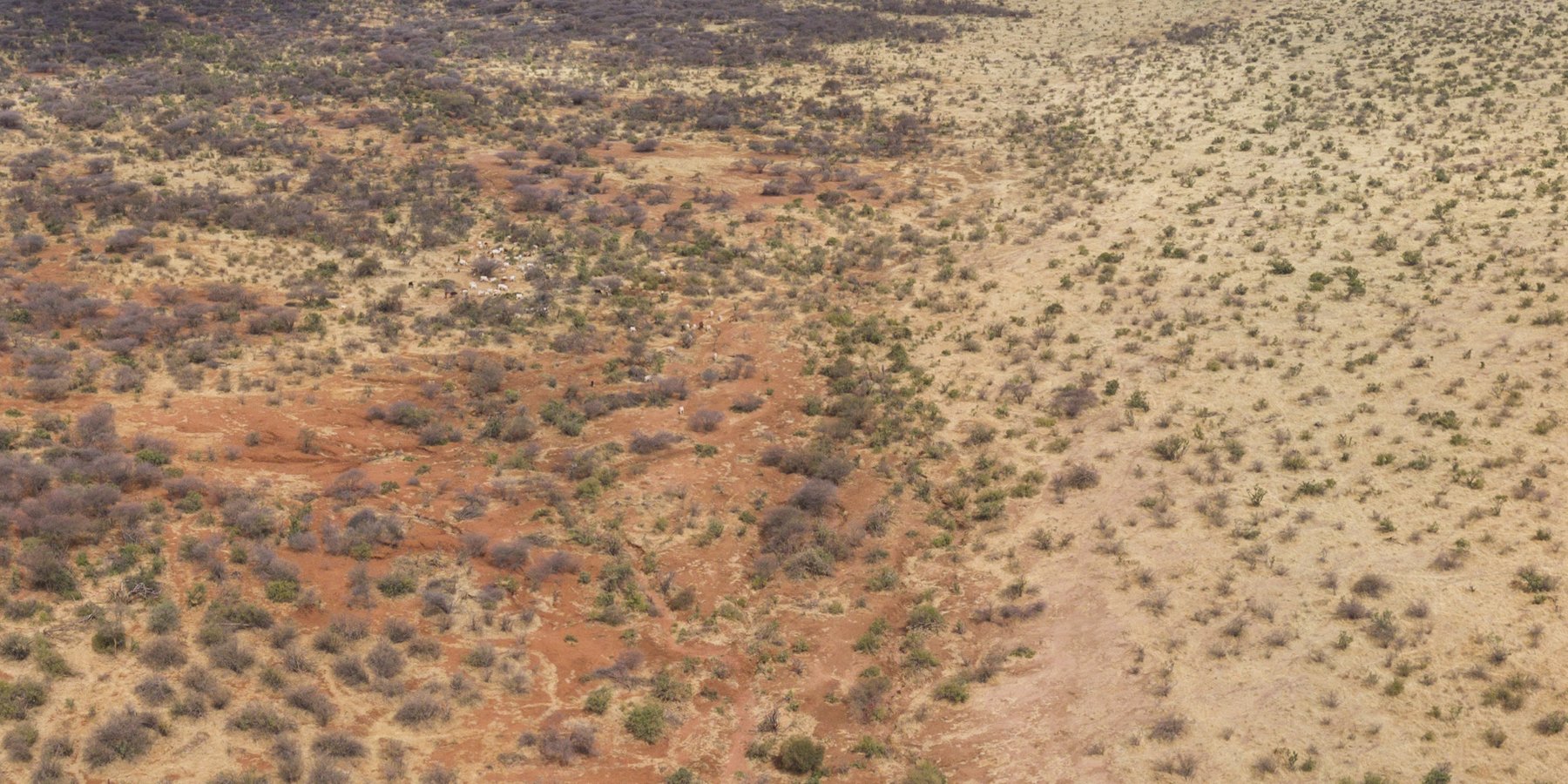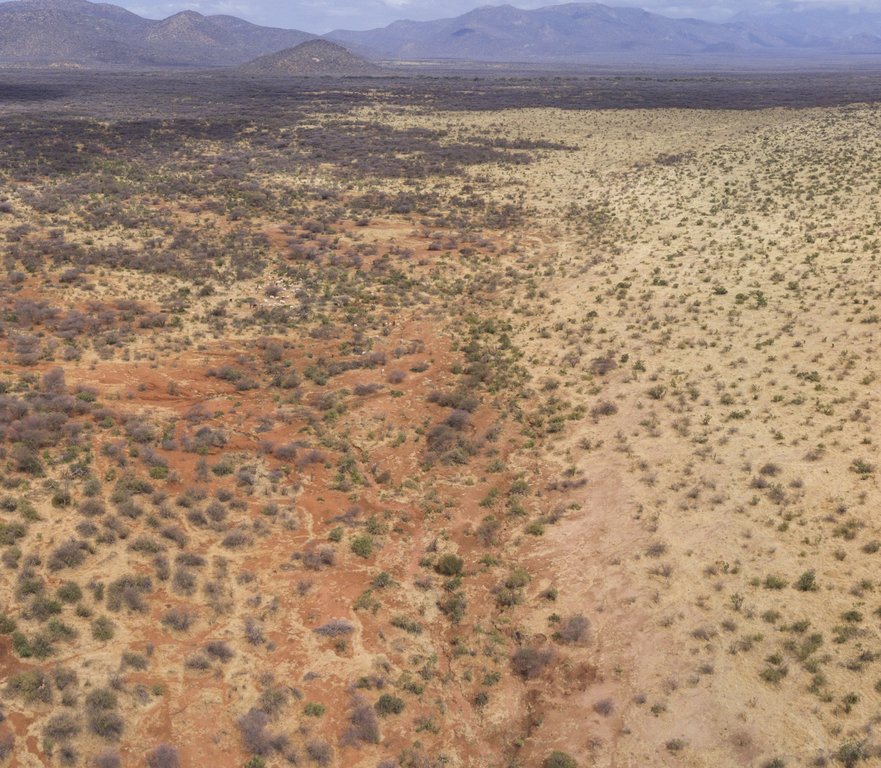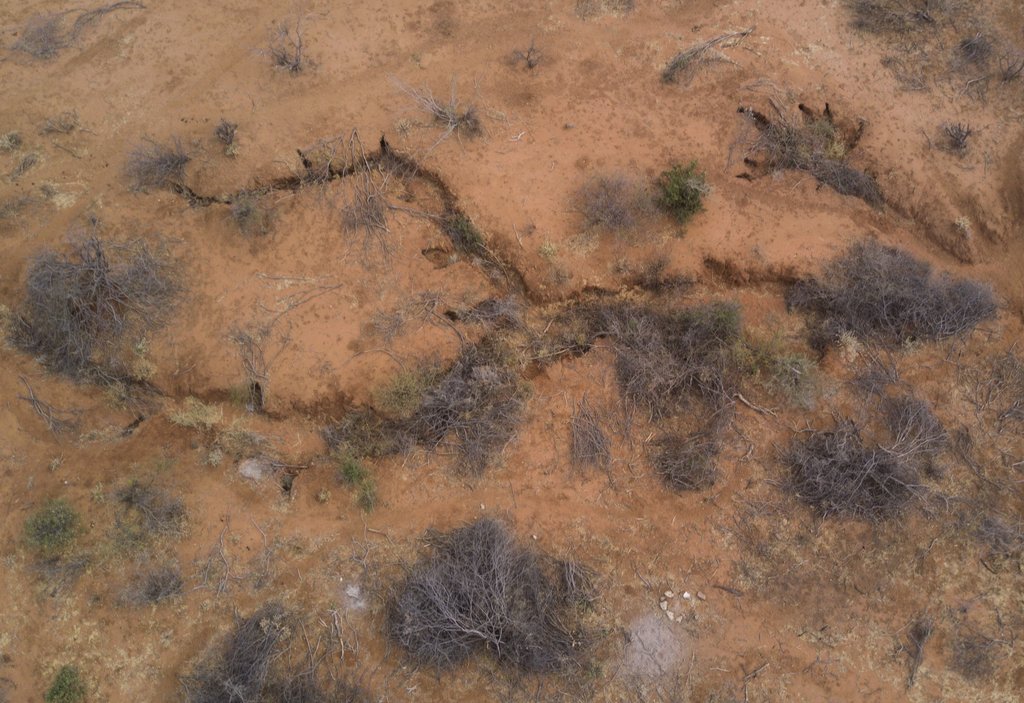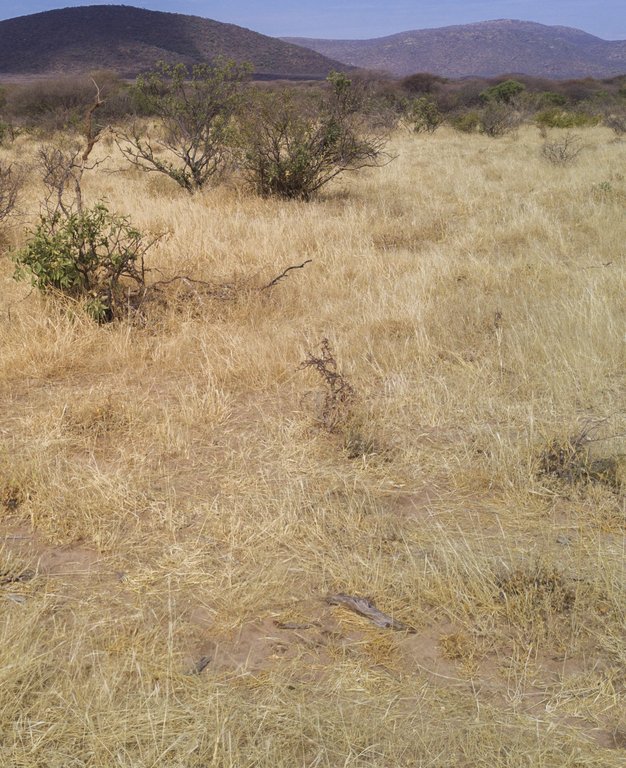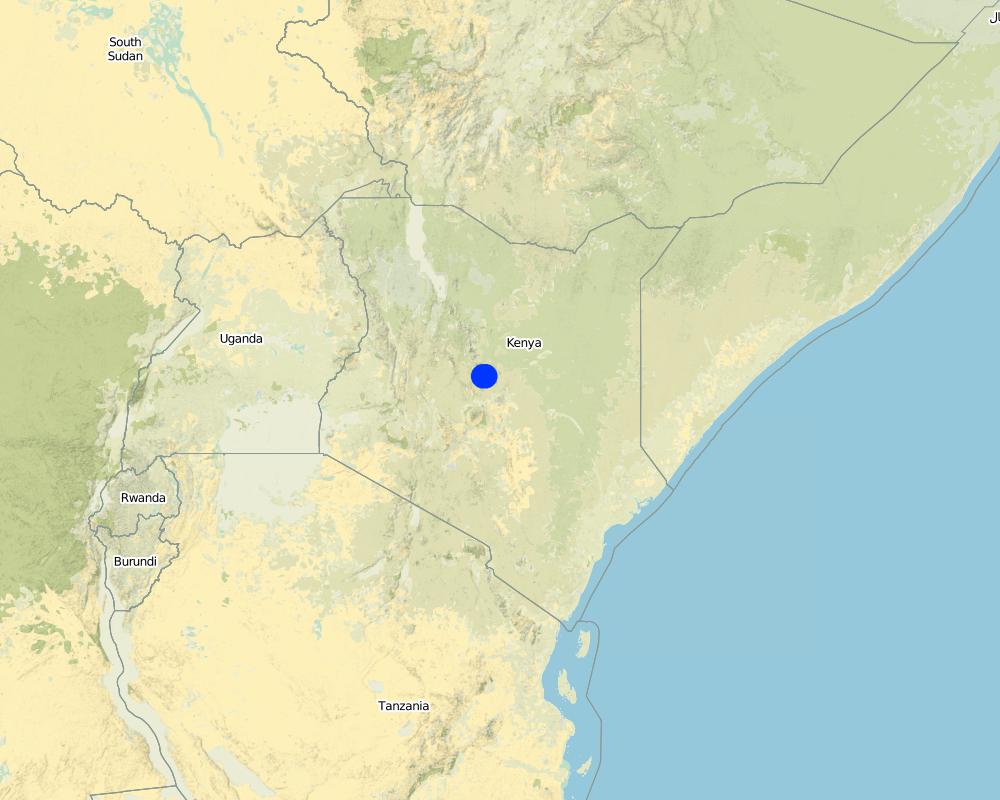Rangeland Restoration by cutting invasive species and grass reseeding and managing grazing [Quênia]
- Criação:
- Atualização:
- Compilador/a: Harry Wells
- Editor: –
- Revisores: Hanspeter Liniger, Rima Mekdaschi Studer, Barbara *, Donia Mühlematter, Alexandra Gavilano
technologies_3381 - Quênia
- Resumo completo em PDF
- Resumo completo em PDF para impressão
- Resumo completo no navegador
- Resumo completo (sem formatação)
- Rangeland Restoration by cutting invasive species and grass reseeding and managing grazing: 16 de Julho de 2018 (inactive)
- Rangeland Restoration by cutting invasive species and grass reseeding and managing grazing: 6 de Maio de 2019 (inactive)
- Rangeland Restoration by cutting invasive species and grass reseeding and managing grazing: 3 de Setembro de 2018 (inactive)
- Rangeland Restoration by cutting invasive species and grass reseeding and managing grazing: 2 de Novembro de 2021 (public)
- Rangeland Restoration by cutting invasive species and grass reseeding and managing grazing : 23 de Março de 2018 (inactive)
Veja as seções
Expandir tudo Recolher tudo1. Informação geral
1.2 Detalhes do contato das pessoas capacitadas e instituições envolvidas na avaliação e documentação da tecnologia
co-compilador/a:
1.3 Condições em relação ao uso da informação documentada através de WOCAT
O/a compilador/a e a(s) pessoa(s) capacitada(s) aceitam as condições relativas ao uso de dados documentados através da WOCAT:
Sim
1.4 Declaração de sustentabilidade da tecnologia descrita
A tecnologia descrita aqui é problemática em relação a degradação da terra de forma que não pode ser declarada uma tecnologia de gestão sustentável de terra?
Não
2. Descrição da tecnologia de GST
2.1 Descrição curta da tecnologia
Definição da tecnologia:
This 'Rangeland Restoration' technology is part of a 'Holistic Rangeland Management' approach. It involves clearing of invasive vegetation (predominantly Acacia reficiens) and reseeding with grass (Cenchrus ciliaris) and allowing resting and reduced grazing pressure to rehabilitate degraded communal grazing land.
2.2 Descrição detalhada da tecnologia
Descrição:
The 'Rangeland Restoration' technology is applied in degraded sites within the 3,100 Ha 'core conservation area' (an central area with minimised grazing pressure designated for tourism) and 'buffer zone' (an area surrounding the 'core conservation area' with reduced grazing pressure) of the Kalama Community Wildlife Conservancy (total area: 9,500 Ha).
The main characteristics are clearing of invasive woody vegetation (predominantly Acacia reficiens) and reseeding with grass (Cenchrus ciliaris). Acacia reficiens (commonly known as red-bark acacia, red thorn or false umbrella tree or thorn) is a native tree or shrub but is considered an invasive species as it can encroach degraded areas with bare and disturbed soil. It is very opportunistic and hardy and can subsequently take over large areas of native vegetation. The invasion can reach a closed or nearly closed canopy with A. reficiens thickets, which are hindering animals to enter and access fodder thus making the area inaccessible for grazing and browsing. Additionally it can be observed that the soil underneath the canopy remains bare and the grass growth seems to be suppressed. As a result the top soil is compacted or forms crusts, which hinder infiltration. During the erratic but heavy rains most of the water flows away as runoff (research in close by areas show that runoff is between 60-80 % of the rainfall) and increases soil erosion and further degradation of the land despite a rather good tree cover. Rangeland grass and fodder productivity in these areas are reduced to a fraction of their potential.
The main activity is the cutting of the trees and shrubs at a height of ~1 m. The main trunks and branches can be used for fencing, temporary house constructions, firewood and charcoal. Most of the cut trees and the remaining branches are used to spread on the bare land where the trees and shrubs are cut. Underneath this dead material the bare soil receives some cover, which creates favorable conditions and microclimate for termites and other fauna in the soil to brake the hard top soil and crust and enable infiltration of the water during the next rains. This allows regrowth of grasses, particularly in the areas protected by the branches. In the following seasons the spread of the grasses can increase also the the area not protected by the branches. Additionally, seeding with Cenchrus ciliaris (buffel-grass or African foxtail grass), a grass species which is native to most of Africa, enhances the growth of a highly valuable fodder grass. Seeds are hand-broadcasted in the treated areas and germinate during the next rainy season. The first greening is visible in the places where the branches and the wood pieces cover the soil. From there the local annual and perennial grasses start colonising and expanding in the following seasons until, ideally, the whole area that has been bare is covered by valuable perennial grasses. Parallel to the cutting and reseeding is reduced grazing pressure and a resting period over at least one dry season, which is facilitated by the fact that treated areas are situated in the core conservation area or in the buffer zone. This involves the cooperation of the members of Kalama Conservancy, who agree to restrict grazing in the buffer zone and more so in the core conservation area. The exact duration that grazing is allowed in each of these two areas varies year to year depending on drought severity and forage availability. Whereas the grazing pressure by livestock can be regulated, there remains uncontrolled grazing by wildlife. The major herbivores are zebra, elephants and a number of different gazelle and antelope species the grazing pressure by wildlife varies but can be substantial at certain times.
Rehabilitating degraded grazing land is the primary purpose of the technology. Other benefits of the technology include: 1) augmented forage availability for the community; 2) increased livestock production; 3) reduced soil erosion and flooding. Land users enjoy these benefits but would like larger areas to be similarly restored. However, the limiting factor is the funding required to pay for labour, which is the major input required for the clearing and reseeding activities. Establishing a market for removing the main stems and producing and selling charcoal is still an opportunity to further explore immediate benefits and cash income in order to pay for the investment into the clearing.
2.3 Fotos da tecnologia
2.5 País/região/locais onde a tecnologia foi aplicada e que estão cobertos nesta avaliação
País:
Quênia
Região/Estado/Província:
Samburu County
Especifique a difusão da tecnologia:
- Aplicado em pontos específicos/concentrado numa pequena área
Map
×2.6 Data da implementação
Indique o ano de implementação:
2006
Caso o ano exato seja desconhecido, indique a data aproximada:
- 10-50 anos atrás
2.7 Introdução da tecnologia
Especifique como a tecnologia foi introduzida:
- através de projetos/intervenções externas
Comentários (tipos de projeto, etc.):
Acacia reficiens was already selectively cleared traditionally when constructing livestock corrals ('bomas'), but the introduction of more extensive clearing and grass-reseeding to rehabilitate specific areas was facilitated by Northern Rangeland Trust and Grevy's Zebra Trust.
3. Classificação da tecnologia de GST
3.1 Principal/principais finalidade(s) da tecnologia
- Reduz, previne, recupera a degradação do solo
- Preserva ecossistema
- Preservar/melhorar a biodiversidade
3.2 Tipo(s) atualizado(s) de uso da terra onde a tecnologia foi aplicada

Pastagem
Pastagem extensiva:
- Pastoralismo semi-nômade
- Fazenda pecuária
Tipo de animal:
- gado - carne bovina não-láctea
- gado - lácteo
- caprinos
- camelos
- mulas e jumentos
- ovelhas
Produtos e serviços:
- leite
- carne

Terra improdutiva
Especifique:
Bare and/or degraded land
Observações:
The area has been overused and continuously grazed for a long period of time without given the land and vegetation a break to recover. Thus a vicious spiral developed: the reduced grass cover lead to degradation of the soil to compaction and crusting, reduced infiltration thus reduced runoff and reduced vegetation growth, which in turn increased the pressure on the remaining vegetation and thus more base soil etc.
Comentários:
Number of growing seasons per year: 2
Specify: Rainiy seasons from April to June and from October to December but with high variability in time and amount
Livestock density: likely continuously growing till technology was introduced
3.4 Abastecimento de água
Abastecimento de água para a terra na qual a tecnologia é aplicada:
- Precipitação natural
3.5 Grupo de GST ao qual pertence a tecnologia
- Gestão de pastoralismo e pastagem
- Solo/cobertura vegetal melhorada
- variedades vegetal/raças de animais melhoradas
3.6 Medidas de GST contendo a tecnologia

Medidas vegetativas
- V2: gramíneas e plantas herbáceas perenes
- V4: Substituição ou retirada de espécies exóticas/invasivas

Medidas de gestão
- M2: Mudança de gestão/nível de intensidade
3.7 Principais tipos de degradação da terra abordados pela tecnologia

Erosão do solo pela água
- Wt: Perda do solo superficial/erosão de superfície
- Wg: Erosão por ravinas/ravinamento

Deteriorização física do solo
- Pc: Compactação
- Pk: quebra e ressecamento

Degradação biológica
- Bc: redução da cobertura vegetal
- Bs: Qualidade e composição de espécies/declínio de diversidade
- Bl: perda da vida do solo

Degradação da água
- Ha: aridificação
3.8 Redução, prevenção ou recuperação da degradação do solo
Especifique o objetivo da tecnologia em relação a degradação da terra:
- Reduzir a degradação do solo
- Recuperar/reabilitar solo severamente degradado
4. Especificações técnicas, implementação de atividades, entradas e custos
4.1 Desenho técnico da tecnologia
Especificações técnicas (relacionada ao desenho técnico):
A total of 279 hectares were treated with this rangeland restoration technology (clearing invasive Acacia reficiens and reseeding with Cenchrus ciliaris). Treated areas were relatively flat (slope < 5%). A. reficiens were cut ~1 m above the ground and well before the onset of the rains to discourage regeneration. C. ciliaris seeds were hand-broadcast at a rate of ~45 kg/Ha.
Holding membership of multiple community conservancies facilitates the movement between wet season and dry season grazing areas. For example, many of the local communities move their livestock to Losesia, in Sera Conservancy, for dry season grazing. These porous boundaries relieve pressure from Kalama Conservancy during some parts of the year, potentially facilitating recovery of treated areas, but also allows neighbouring communities to access treated areas rendering their grazing management challenging.
Autor:
Harry Wells
Data:
06/03/2018
4.2 Informação geral em relação ao cálculo de entradas e custos
Especifique como custos e entradas foram calculados:
- por área de tecnologia
Indique o tamanho e a unidade de área:
279 hectares (total over 6 sites)
Outro/moeda nacional (especifique):
Kenya Shillings
Se for relevante, indique a taxa de câmbio do USD para moeda local (por exemplo, 1 USD = 79,9 Real): 1 USD =:
101,0
Indique a média salarial da mão-de-obra contratada por dia:
450 Kenya Shillings
4.3 Atividades de implantação
| Atividade | Periodicidade (estação do ano) | |
|---|---|---|
| 1. | Clearing Acacia reficiens (cutting and spreading) | During dry season, well before the onset of rains to prevent Acacia reficiens regrowth from stump. |
| 2. | Reseeding with Cenchrus ciliaris grass seed | Prior to the onset of rainy season to maximise germination and establishment of Cenhrus ciliaris.. |
4.4 Custos e entradas necessárias para a implantação
| Especifique a entrada | Unidade | Quantidade | Custos por unidade | Custos totais por entrada | % dos custos arcados pelos usuários da terra | |
|---|---|---|---|---|---|---|
| Mão-de-obra | Clearing Acacia reficiens | person-days | 1200,0 | 450,0 | 540000,0 | |
| Mão-de-obra | Hand-broadcasting Cenchrus ciliaris seeds | person-days | 1200,0 | 450,0 | 540000,0 | |
| Equipamento | Machettes | units | 40,0 | 500,0 | 20000,0 | |
| Material vegetal | Cenchrus ciliaris seeds | kg | 2520,0 | 50,0 | 126000,0 | |
| Outros | Transport of workers to and from site | litre | 600,0 | 100,0 | 60000,0 | |
| Custos totais para a implantação da tecnologia | 1286000,0 | |||||
| Custos totais para o estabelecimento da Tecnologia em USD | 12732,67 | |||||
Se o usuário da terra arca com menos que 100% dos custos, indique quem cobre os custos remanescentes:
Funding raised by Northern Rangelands Trust and Grezy's Zebra Trust (including USAID and FAO funding).
Comentários:
These are the costs associated a 55 Ha treated area. Six sites of a similar size were treated with similar budgets totalling 279 Ha.
4.5 Atividades recorrentes/manutenção
Comentários:
No maintenance activities.
4.6 Custos e entradas necessárias pata a manutenção/atividades recorrentes (por ano)
Comentários:
No maintenance costs.
4.7 Fatores mais importantes que afetam os custos
Descreva os fatores mais determinantes que afetam os custos:
Hiring labour, as it was the most costly component.
5. Ambiente natural e humano
5.1 Clima
Precipitação pluviométrica anual
- <250 mm
- 251-500 mm
- 501-750 mm
- 751-1.000 mm
- 1.001-1.500 mm
- 1.501-2.000 mm
- 2.001-3.000 mm
- 3.001-4.000 mm
- > 4.000 mm
Especifique a média pluviométrica anual em mm (se conhecida):
351,00
Indique o nome da estação meteorológica de referência considerada:
Archer's Post
Zona agroclimática
- Semiárido
5.2 Topografia
Declividade média:
- Plano (0-2%)
- Suave ondulado (3-5%)
- Ondulado (6-10%)
- Moderadamente ondulado (11-15%)
- Forte ondulado (16-30%)
- Montanhoso (31-60%)
- Escarpado (>60%)
Formas de relevo:
- Planalto/planície
- Cumes
- Encosta de serra
- Encosta de morro
- Sopés
- Fundos de vale
Zona de altitude:
- 0-100 m s.n.m.
- 101-500 m s.n.m.
- 501-1.000 m s.n.m.
- 1.001-1.500 m s.n.m.
- 1.501-2.000 m s.n.m.
- 2.001-2.500 m s.n.m.
- 2.501-3.000 m s.n.m.
- 3.001-4.000 m s.n.m.
- > 4.000 m s.n.m.
Indique se a tecnologia é aplicada especificamente em:
- Não relevante
5.3 Solos
Profundidade do solo em média:
- Muito raso (0-20 cm)
- Raso (21-50 cm)
- Moderadamente profundo (51-80 cm)
- Profundo (81-120 cm)
- Muito profundo (>120 cm)
Textura do solo (solo superficial):
- Grosso/fino (arenoso)
Textura do solo (>20 cm abaixo da superfície):
- Grosso/fino (arenoso)
Matéria orgânica do solo superficial:
- Baixo (<1%)
Caso disponível anexe a descrição completa do solo ou especifique as informações disponíveis, p. ex. tipo de solo, PH/acidez do solo, nitrogênio, capacidade de troca catiônica, salinidade, etc.
pH ~7-8.5; SOC 4.7 g/kg of soil; Na ~0.1-0.4 cmolc/kg
5.4 Disponibilidade e qualidade de água
Lençol freático:
> 50 m
Disponibilidade de água de superfície:
Precário/nenhum
Qualidade da água (não tratada):
Água potável precária (tratamento necessário)
A salinidade da água é um problema?
Não
Ocorre inundação da área?
Não
5.5 Biodiversidade
Diversidade de espécies:
- Alto
Diversidade de habitat:
- Médio
Comentários e outras especificações sobre biodiversidade:
Rangelands in Kenya are generally characterized by high bio-diversity. The particular sites have been degraded in terms of vegetation ans soils. After the restoration diversity increases but has not reached its full potential.
5.6 Características dos usuários da terra que utilizam a tecnologia
Sedentário ou nômade:
- Semi-nômade
Orientação de mercado do sistema de produção:
- misto (subsistência/comercial)
Rendimento não agrícola:
- >50% de toda renda
Nível relativo de riqueza:
- Média
Indivíduos ou grupos:
- Grupos/comunidade
Nível de mecanização:
- Trabalho manual
Gênero:
- Homens
Idade dos usuários da terra:
- Jovens
- meia-idade
Indique outras características relevantes dos usuários da terra:
Kalama Conservancy receives considerable income from the high end tourism (~60% of total income) and donations (~25% of total income).
5.7 Área média de terrenos utilizados pelos usuários de terrenos que aplicam a Tecnologia
- < 0,5 ha
- 0,5-1 ha
- 1-2 ha
- 2-5 ha
- 5-15 ha
- 15-50 ha
- 50-100 ha
- 100-500 ha
- 500-1.000 ha
- 1.000-10.000 ha
- > 10.000 ha
É considerado pequena, média ou grande escala (referente ao contexto local)?
- Grande escala
Comentários:
communally owned
5.8 Propriedade de terra, direitos de uso da terra e de uso da água
Propriedade da terra:
- Comunitário/rural
Direitos do uso da terra:
- Comunitário (organizado)
Direitos do uso da água:
- Comunitário (organizado)
5.9 Acesso a serviços e infraestrutura
Saúde:
- Pobre
- Moderado
- Bom
Educação:
- Pobre
- Moderado
- Bom
Assistência técnica:
- Pobre
- Moderado
- Bom
Emprego (p. ex. não agrícola):
- Pobre
- Moderado
- Bom
Mercados:
- Pobre
- Moderado
- Bom
Energia:
- Pobre
- Moderado
- Bom
Vias e transporte:
- Pobre
- Moderado
- Bom
Água potável e saneamento:
- Pobre
- Moderado
- Bom
Serviços financeiros:
- Pobre
- Moderado
- Bom
6. Impactos e declarações finais
6.1 Impactos no local mostrados pela tecnologia
Impactos socioeconômicos
Produção
Produção de forragens
Comentários/especificar:
due to degradation fodder production before was minimal both for grasses (hardly that survived the grazing pressure) as well as accessible browse material
Qualidade da forragem
Comentários/especificar:
perennial grasses were brought back
Produção animal
Produção de madeira
Comentários/especificar:
cut wood of the invasive species can be used for charcoal production, and construction material. The amount is high but the marketing is still weak, so most of it is left to be spread on the ground
Qualidade da floresta/do bosque
Comentários/especificar:
one dominate invasive wood species was removed to give way for other native species to repopulate the area
Impactos socioculturais
Segurança alimentar/auto-suficiência
Conhecimento de GST/ degradação da terra
Atenuação de conflitos
Impactos ecológicos
Ciclo hídrico/escoamento
Escoamento superficial
Comentários/especificar:
There is still potential to decrease runoff further as the system is still recovering and improving.
Solo
Umidade do solo
Cobertura do solo
Perda de solo
Ressecamento/ selagem do solo
Compactação do solo
Ciclo e recarga de nutrientes
Matéria orgânica do solo/carbono abaixo do solo
Biodiversidade: vegetação, animais
Cobertura vegetal
Biomassa/carbono acima do solo
Diversidade vegetal
6.2 Impactos externos mostrados pela tecnologia
Cheias de jusante
Sedimentação a jusante
Danos na infraestrutura pública/privada
Comentários/especificar:
damage on major bridges but also on smaller within the conservancy
6.3 Exposição e sensibilidade da tecnologia às mudanças climáticas graduais e extremos/desastres relacionados ao clima (conforme o ponto de vista dos usuários da terra)
Mudança climática gradual
Mudança climática gradual
| Estação do ano | aumento ou diminuição | Como a tecnologia lida com isso? | |
|---|---|---|---|
| Temperatura anual | aumento | moderadamente |
Extremos (desastres) relacionados ao clima
Desastres meteorológicos
| Como a tecnologia lida com isso? | |
|---|---|
| Temporal local | muito bem |
Desastres climatológicos
| Como a tecnologia lida com isso? | |
|---|---|
| Seca | bem |
6.4 Análise do custo-benefício
Como os benefícios se comparam aos custos de implantação (do ponto de vista dos usuários da terra)?
Retornos a curto prazo:
positivo
Retornos a longo prazo:
muito positivo
6.5 Adoção da tecnologia
- casos isolados/experimental
De todos aqueles que adotaram a Tecnologia, quantos o fizeram espontaneamente, ou seja, sem receber nenhum incentivo/ pagamento material?
- 0-10%
6.6 Adaptação
A tecnologia foi recentemente modificada para adaptar-se as condições variáveis?
Não
6.7 Pontos fortes/vantagens/oportunidades da tecnologia
| Pontos fortes/vantagens/oportunidades na visão do usuário da terra |
|---|
| Land that was previously considered unproductive is now considered grazing land. |
| Increased infiltration and decreased runoff and water erosion. |
| Recolonisation by local grasses and forbs to replace reseeded Cenchrus ciliaris after 1-2 years provides nutritious forage (particularly the forbs) for livestock. |
| Pontos fortes/vantagens/oportunidades na visão do/a compilador/a ou de outra pessoa capacitada |
|---|
| Decreased impact of the invasive Acacia reficiens on vegetation and soil within treated areas. |
| Increased biomass of herbaceous vegetation for livestock and wildlife forage. |
| Augmented biodiversity after reseeded Cenchrus ciliaris replaced by local grasses and forbs. |
6.8 Pontos fracos, desvantagens/riscos da tecnologia e formas de superá-los
| Pontos fracos/desvantagens/riscos na visão do usuário da terra | Como eles podem ser superados? |
|---|---|
| Creates overly high expectations from the community regarding the potential to restore larger areas. | Raise awareness among community members regarding the limitations of large-scale restoration. |
| Lack of funds to pay labourers. Paying community members to undertake restoration activities rather than these activities being voluntary is now, in hindsight, perceived to have been a mistake. | There will never be enough funding as labourers will continue to expect ever-increasing wages. However, over time, community members may decide to restore land voluntarily. Explore the potential for marketing the main trunks for charcoal production of firewood to pay for the labourers. |
| Controlling grazing in recovering areas. | Raise awareness about the restoration projects within immediate and neighbouring communities. Also, ensure grazing by-laws are implemented and offenders fined. |
| Land users unwilling to voluntarily take part in restoration activities. | Increase ownership by conducting restoration projects at more local zonal-levels rather than at the conservancy-level. Create additional incentives by using and marketing of some of the wood material (for legal charcoal production) |
| Pontos fracos/vantagens/riscos na visão do/a compilador/a ou de outra pessoa capacitada | Como eles podem ser superados? |
|---|---|
| Inability to provide adequate rest to treated areas (i.e. by controlling grazing pressure) leading to unsuccessful establishment of Cenchrus ciliaris or other herbaceous vegetation in treated areas, particularly in 'buffer zone'. | Implement grazing rules more stringently. |
| Lack of capacity regarding how to reseed Cenchrus ciliaris in some treated areas. In one case, seeds were buried (as farmers do with maize seeds), which is reported to have contributed to low establishment success of C. ciliaris seeds. | Capacity building. |
| Germination and establishment of Cenchrus ciliaris depends on timing in relation to the onset of rains, which are unpredictable and led to unsuccessful rehabilitation of some treated areas. | Provide most accurate weather forecasts available. |
7. Referências e links
7.1 Métodos/fontes de informação
- visitas de campo, pesquisas de campo
2 field visits to the sites
- entrevistas com usuários de terras
3 informants
- compilação de relatórios e outra documentação existente
1 report
Quando os dados foram compilados (no campo)?
26/01/2018
7.2 Referências às publicações disponíveis
Título, autor, ano, ISBN:
'Northern Rangeland Trust: Baseline assessment of rangeland health - Kalama and Namunyak conservancies', Tor-G. Vågen & Leigh A. Winowiecki, 2014
Disponível de onde? Custos?
https://cgspace.cgiar.org/bitstream/handle/10568/65671/nrtReport_march2014.pdf?sequence=1
7.3 Links para informações on-line relevantes
Título/ descrição:
Northern Rangeland Trust: Baseline assessment of rangeland health - Kalama and Namunyak conservancies
URL:
https://cgspace.cgiar.org/bitstream/handle/10568/65671/nrtReport_march2014.pdf?sequence=1
Links e módulos
Expandir tudo Recolher tudoLinks
Não há links
Módulos
Não há módulos


